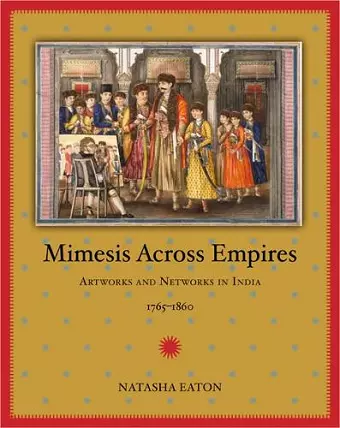Mimesis across Empires
Artworks and Networks in India, 1765-1860
Format:Paperback
Publisher:Duke University Press
Published:2nd Sep '13
Currently unavailable, and unfortunately no date known when it will be back

Natasha Eaton theorizes the relationship between art and empire through analysis of the interconnected visual cultures of British and Mughal empires in eighteenth- and nineteenth-century India.
In Mimesis Across Empires, Natasha Eaton examines the interactions, attachments, and crossings between the visual cultures of the Mughal and British Empires during the formative period of British imperial rule in India. Eaton explores how the aesthetics of Mughal "vernacular" art and British "realist" art mutually informed one another to create a hybrid visual economy. By tracing the exchange of objects and ideas—between Mughal artists and British collectors, British artists and Indian subjects, and Indian elites and British artists—she shows how Mughal artists influenced British conceptions of their art, their empire, and themselves, even as European art gave Indian painters a new visual vocabulary with which to critique colonial politics and aesthetics. By placing her analysis of visual culture in relation to other cultural encounters—ethnographic, legislative, diplomatic—Eaton uncovers deeper intimacies and hostilities between the colonizer and the colonized, linking artistic mimesis to the larger colonial project in India.
"Exploding expectations about 'exchange' and 'co-histories,' Natasha Eaton offers a radical and brilliant analysis that perfectly describes the struggle over mimesis in colonial India. 'Alter-aware' imagery and practices are animated in complex dances of intimacy and hostility. A hugely important work."—Christopher Pinney, coeditor of Photography's Other Histories
"This is a genuinely exciting contribution to visual culture studies and postcolonial art history, offering a rich and wide-ranging account of mimesis in various imperial and South Asian representational exchanges over the crucial period from the establishment of the British East India Company to the Uprising. Richly informed by recent philosophy, contemporary art and art theory, and anthropology, among other fields, this book bristles with ambition and provocative ideas."—Nicholas Thomas, coauthor of Art in Oceania: A New History
"Mimesis across Empires presents a strikingly innovative and challenging perspective on British art's relationship to empire and the imperial consciousness, as well as on the role of art and artists in British India. Impressively researched and theoretically well informed, this book considers European and Indian modes of visuality alongside each other in order to reframe the relationship between colonizer and colonized."—Geoff Quilley, author of Empire to Nation: Art, History and the Visualization of Maritime Britain, 1768–1829
“Thoroughly researched, beautifully illustrated, and compellingly argued, the book centers on five case studies of ‘artworks and networks’ that recast the agency of art and the operations of empire through the dynamics of ‘copy and contact’…Highly recommended.” -- S. Khullar * Choice *
"In the wake of the postcolonial turn and the impact of cultural history upon the arts, as well as the significant strides made in the corresponding fields of literature, history, and anthropology, Mimesis Across Empires has taken on the much-needed task of updating our understanding of the cultural transactions in early colonial India with wonderful new material that will hopefully draw more scholars to engage with it." -- Niharika Dinkar * Exemplar *
“Eaton’s formidable study is not merely another instance of art history’s increasing emphasis on cross-cultural exchange, where hyphenated geographies bring into proximity and yet still separate artworks into separate traditions of making and viewing or sensing. Mimesis across Empires instead expertly navigates both British and Indian sources. It behoves art historians to pay attention to its interdisciplinary fluency, as well as to the acuity with which it interweaves theoretical insights and archival findings.” -- Zirwat Chowdhury * Art History *
“The author’s own voice is very much present in the work and she disseminates her extensive research in a thought-provoking and engaging way. The book successfully concludes with a reflection on present-day mimesis in visual culture in the context of neocolonialism in the Middle East. Mimesis Across Empires will be a valuable resource for researchers of Indian visual culture and postcolonial art history. It also offers historians and social scientists useful insights into the complex relationship between the colonisers and the colonised between 1765 and 1860 in India.” -- Megha Rajguru * Visual Studies *
ISBN: 9780822354802
Dimensions: unknown
Weight: 617g
352 pages